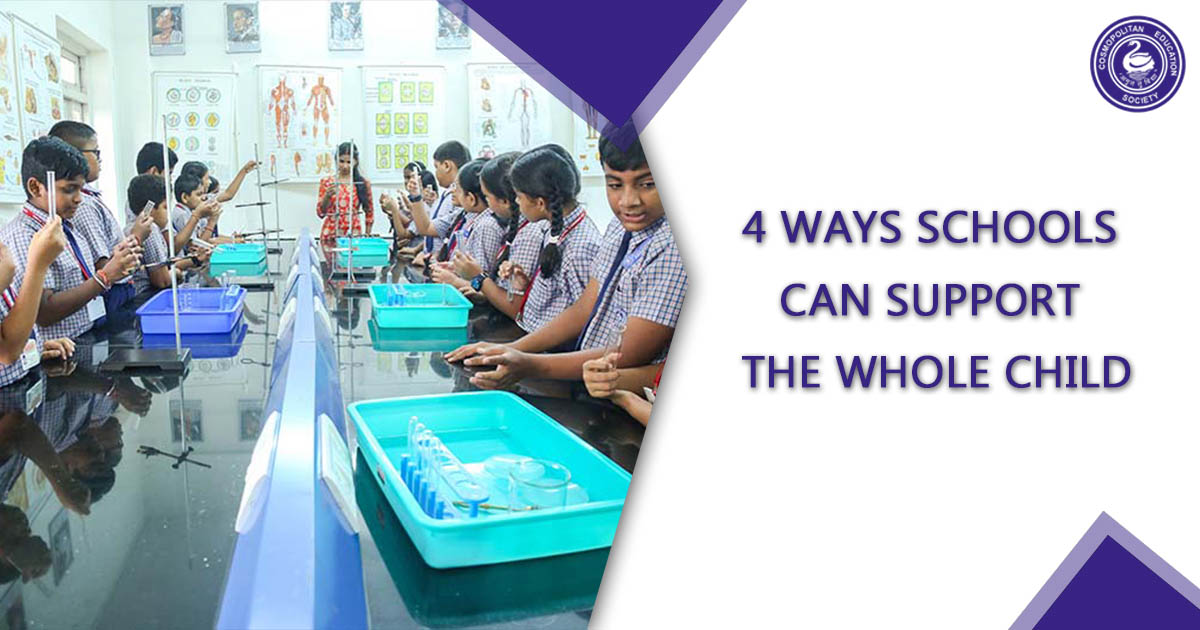
4 Ways Schools Can Support the Whole Child
Currently, the education system in India often emphasizes on a narrow sliver of children’s cognitive development with a focus on transmitting content knowledge, also known as rote learning. Lessons in math, science, and reading – and tests in those skills – dominate the current curriculum.
While those subjects are fundamental, learning involves far more than merely acquiring inert knowledge in algebra or chemistry. Such a restricted focus does not nurture life competencies like growing and learning in their relationships, identity development, enhanced emotional understanding, and overall well-being. After all, children are multi-dimensional “whole” beings whose development is complex and rich.
Below are 4 critical ways schools can support a whole child:
1. Cultivate a supportive environment that promotes strong relationships among staff, students, and families.
In recent research papers, it has been noticed that only 30% of school students rated their school culture positively. This number is of great concern to many schools at present. This is mainly because many schools today have students cycling through classrooms and teachers see hundreds of students a day. These wide structures depersonalize learning at a time when students need and would benefit from long-term relationships with teachers and peers.
Maintaining a healthy student-teacher ratio in your school will aid a positive school climate that is based on strong relationships which provide a base for effective learning. Such an environment will foster a feeling of safety and belonging in the children while in school. Some critical elements you must keep in mind that promote a sense of community and allow teachers to know their students well include:
- Smaller school and class sizes.
- Looping, where teachers stay with the same students for more than one year.
- Advisory classes that provide students with a community and allow teachers to check in with students and parents on a consistent basis.
- Staff who practice cultural competence, inviting students’ experiences into the classroom and communicating that all students are valued.
- Home visits and regular parent-teacher-student conferences to strengthen connections between school and home.
- Opportunities for staff collaboration and leadership that strengthen trust among educators.
For example, a very effective way to help students feel a sense of belongingness is to engage students in developing their own shared classroom norms that are posted and regularly referred to. Additionally, you can assign classroom tasks so that each student is involved in supporting the community. Teachers can also explain their expectations and provide appropriate support to all students, by letting them know that they are capable.
Overall, a positive school climate aims to foster deeper relationships among adults and students to promote a sense of safety and belonging, which are conducive to learning.
2. Administer meaningful, engaging instructional practices that develop students’ ability to manage their own learning.
In research of students who had dropped out of high school, nearly half (47%) said a major reason for dropping out was that classrooms were not interesting. These young children reported being bored and disengaged from school days. Even when asked the cream students of the school, 81% said that there should be more opportunities for real-world learning/experiential learning.
Students in today’s world appreciate and crave to learn things that matter and are relevant to their lives. How can teachers do that while emphasizing curriculum topics? For example, teachers can connect lessons in mathematics to common tasks students are engaged in that use those skills, such as in cooking, artwork, sports, and other settings. We recommend teachers give real-life examples while teaching technical subjects for higher student engagement.
You will not deny when we say, Assessments that include feedback and opportunities to revise work help students learn how to learn and encourage an intrinsic desire to understand the material and challenge themselves, beyond just making the grade. This type of “mastery-oriented approach” is associated with more valuable learning.
Students’ control over their own education is also supported by practices like student-led conferences, which allow students to regularly share their work with parents and teachers and reflect on their learning and goals.
Far from being boring, utilize effective teaching strategies i.e connecting learning to students’ lives, and empowering them to use their knowledge for their own and others’ benefit.
3. Inculcate habits, skills, and mindsets that build students’ social, emotional, and academic competencies
Students in India seem to be more stressed at school 80 percent of the time. Developing students’ social-emotional competency teaches them how to manage stress, while also boosting social skills like collaboration and empathy. In this way, social-emotional skills involve developing greater awareness of oneself and others. These skills should be taken up by moral science or values-driven education teachers.
4. Create an integrated system of school support that includes extended learning opportunities and community partnerships.
Not all children have the capital and materials that give them access to high-quality learning environments and experiences. For example, Only parents who can afford can enroll their children in extra co-curricular activities or tutoring, etc. This creates a big gap between low-income students and affluents.
The community schools model is where public schools partner with families and community organizations to provide well-rounded / Holistic educational opportunities and supports for students’ school success. It typically includes before- and after-school enrichment, such as mentoring and academic support, as well as summer learning opportunities, like workshops on film and art, sports camps, and long-distance trips to visit college campuses.
Additionally, through partnerships with community organizations, schools offer health, mental health, and social services to help students overcome learning barriers. A social worker or community liaison typically coordinates these services. Some schools partner with university programs, as well as health and mental health providers, to bring trainees (like psychology students) into the school as support staff.
Summing up:
Integrating these 4 ingredients are essential to reflect a whole child’s development that maximizes opportunities for all children to succeed. At Shri. Harshad C. Valia International School (CBSE) we emphasize on value-based teaching and learning keeping in mind the all-around development of the students who pass out.
